Economic Report: Crude Oil Price Fluctuations between 1998-2018
VerifiedAdded on 2021/06/14
|8
|2088
|68
Report
AI Summary
This report provides an economic analysis of crude oil price fluctuations between 1998 and 2018, examining the commodity's volatility and its impact on the global economy. The report details the historical trends in crude oil prices, noting significant increases and occasional drops during the specified period. It then delves into the factors driving these fluctuations, including the influence of OPEC on oil supply and pricing, political instability in oil-producing countries, global economic growth (particularly in China), the shift towards environmentally friendly practices, and innovations in fuel-efficient vehicles. Furthermore, the report discusses the welfare implications of these price changes, such as the impact on production costs, consumer prices, household income, and the demand for goods and services. The report concludes by emphasizing the importance of crude oil as a key resource and summarizing the various factors influencing its price, highlighting the implications for the global economy and social welfare.
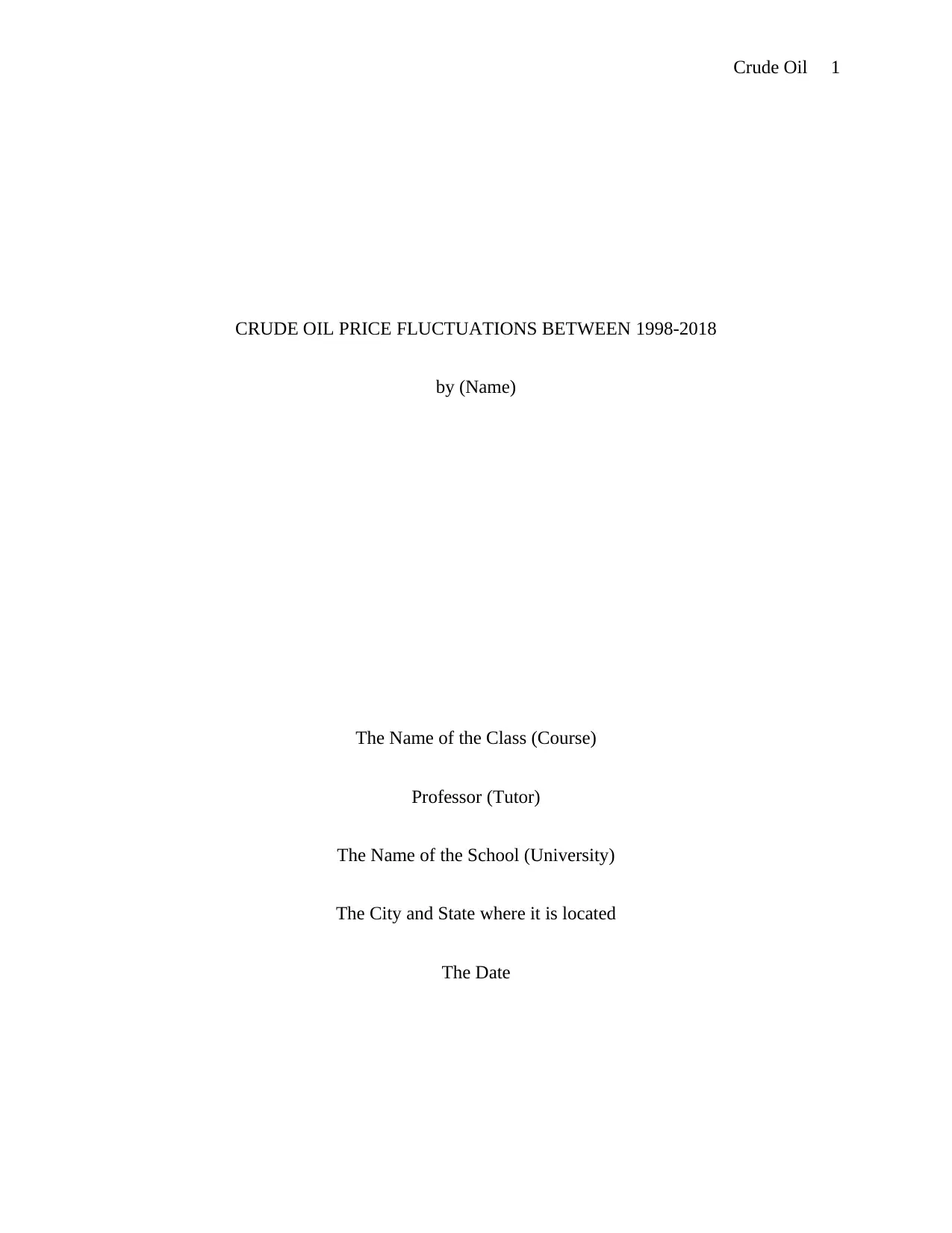
Crude Oil 1
CRUDE OIL PRICE FLUCTUATIONS BETWEEN 1998-2018
by (Name)
The Name of the Class (Course)
Professor (Tutor)
The Name of the School (University)
The City and State where it is located
The Date
CRUDE OIL PRICE FLUCTUATIONS BETWEEN 1998-2018
by (Name)
The Name of the Class (Course)
Professor (Tutor)
The Name of the School (University)
The City and State where it is located
The Date
Paraphrase This Document
Need a fresh take? Get an instant paraphrase of this document with our AI Paraphraser
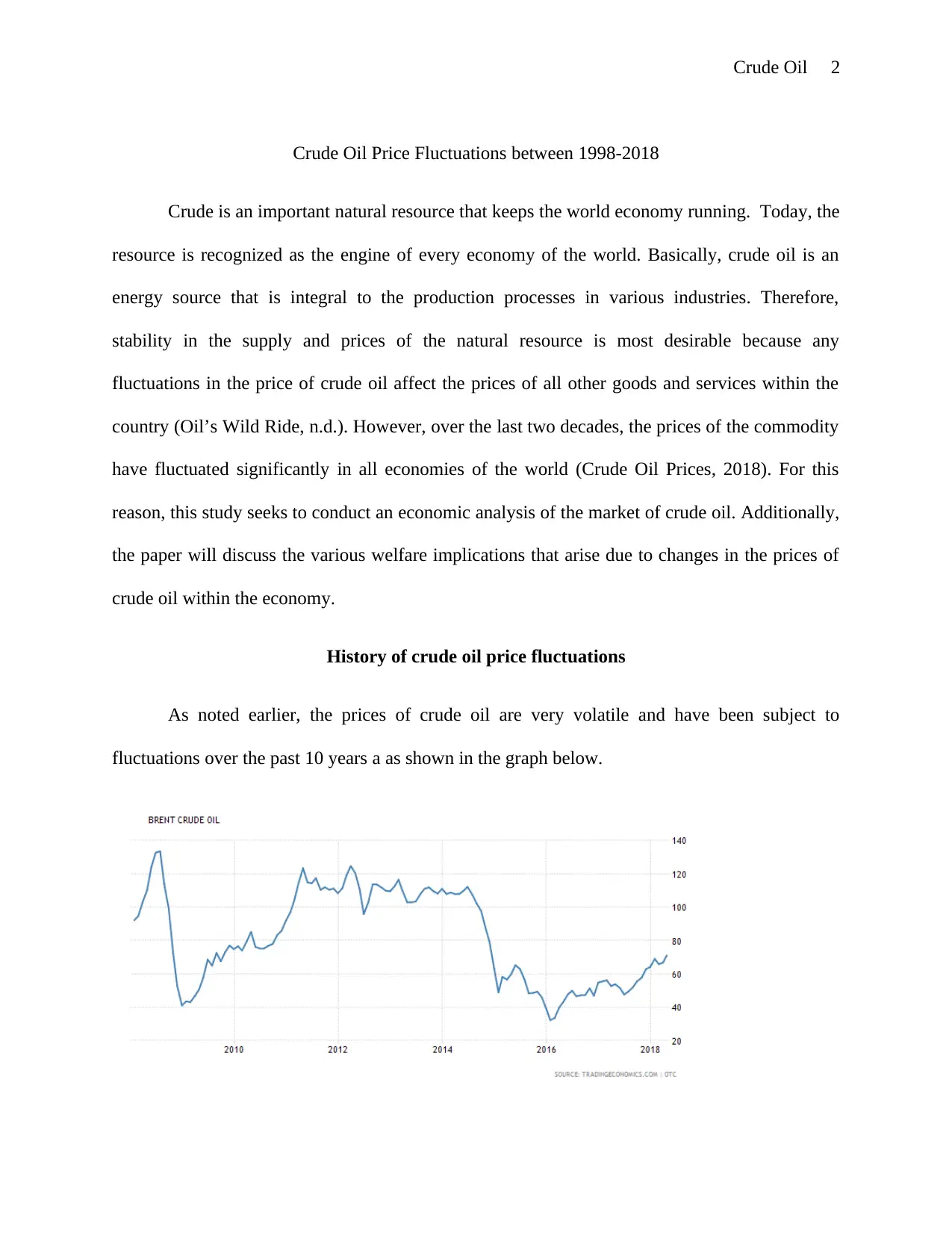
Crude Oil 2
Crude Oil Price Fluctuations between 1998-2018
Crude is an important natural resource that keeps the world economy running. Today, the
resource is recognized as the engine of every economy of the world. Basically, crude oil is an
energy source that is integral to the production processes in various industries. Therefore,
stability in the supply and prices of the natural resource is most desirable because any
fluctuations in the price of crude oil affect the prices of all other goods and services within the
country (Oil’s Wild Ride, n.d.). However, over the last two decades, the prices of the commodity
have fluctuated significantly in all economies of the world (Crude Oil Prices, 2018). For this
reason, this study seeks to conduct an economic analysis of the market of crude oil. Additionally,
the paper will discuss the various welfare implications that arise due to changes in the prices of
crude oil within the economy.
History of crude oil price fluctuations
As noted earlier, the prices of crude oil are very volatile and have been subject to
fluctuations over the past 10 years a as shown in the graph below.
Crude Oil Price Fluctuations between 1998-2018
Crude is an important natural resource that keeps the world economy running. Today, the
resource is recognized as the engine of every economy of the world. Basically, crude oil is an
energy source that is integral to the production processes in various industries. Therefore,
stability in the supply and prices of the natural resource is most desirable because any
fluctuations in the price of crude oil affect the prices of all other goods and services within the
country (Oil’s Wild Ride, n.d.). However, over the last two decades, the prices of the commodity
have fluctuated significantly in all economies of the world (Crude Oil Prices, 2018). For this
reason, this study seeks to conduct an economic analysis of the market of crude oil. Additionally,
the paper will discuss the various welfare implications that arise due to changes in the prices of
crude oil within the economy.
History of crude oil price fluctuations
As noted earlier, the prices of crude oil are very volatile and have been subject to
fluctuations over the past 10 years a as shown in the graph below.
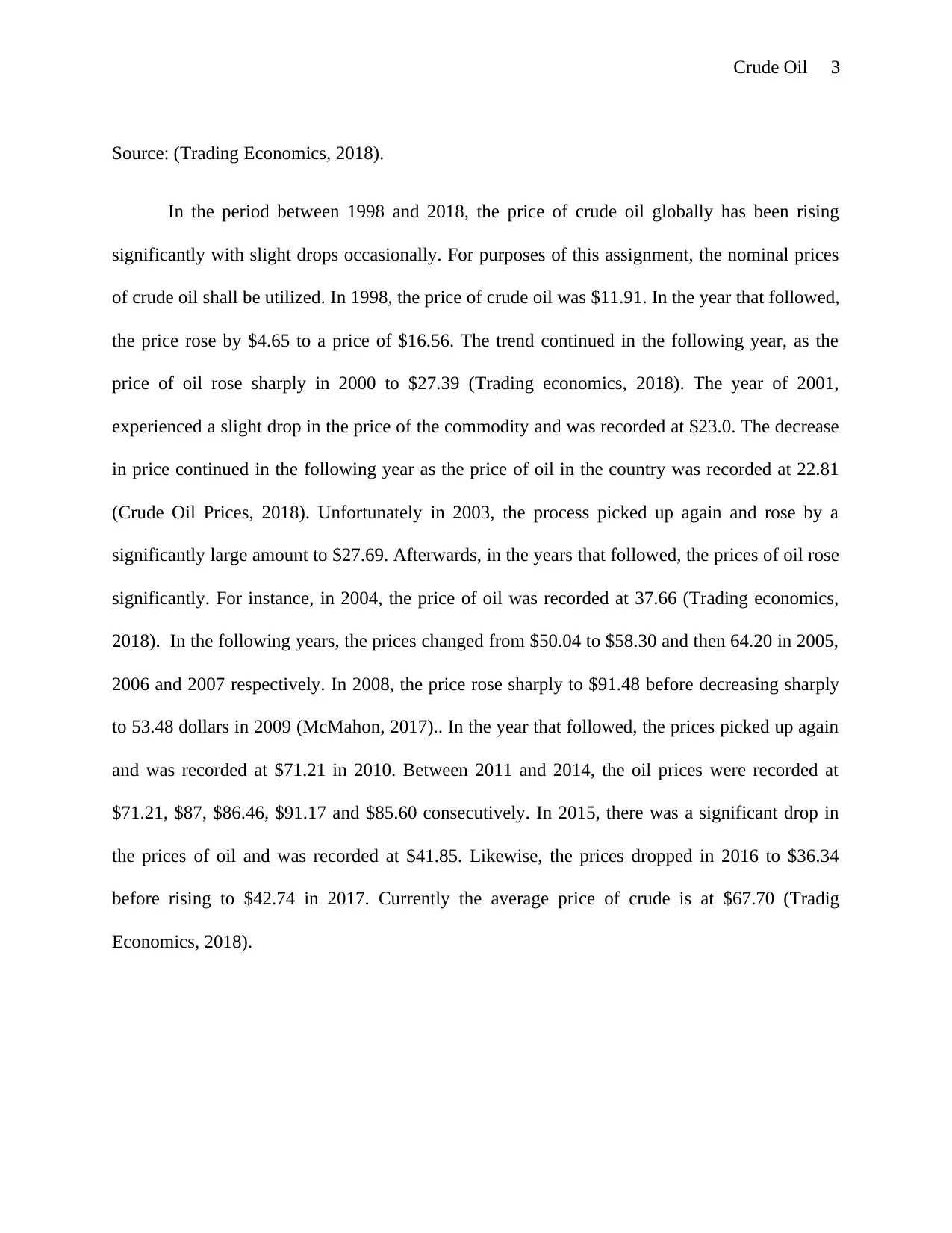
Crude Oil 3
Source: (Trading Economics, 2018).
In the period between 1998 and 2018, the price of crude oil globally has been rising
significantly with slight drops occasionally. For purposes of this assignment, the nominal prices
of crude oil shall be utilized. In 1998, the price of crude oil was $11.91. In the year that followed,
the price rose by $4.65 to a price of $16.56. The trend continued in the following year, as the
price of oil rose sharply in 2000 to $27.39 (Trading economics, 2018). The year of 2001,
experienced a slight drop in the price of the commodity and was recorded at $23.0. The decrease
in price continued in the following year as the price of oil in the country was recorded at 22.81
(Crude Oil Prices, 2018). Unfortunately in 2003, the process picked up again and rose by a
significantly large amount to $27.69. Afterwards, in the years that followed, the prices of oil rose
significantly. For instance, in 2004, the price of oil was recorded at 37.66 (Trading economics,
2018). In the following years, the prices changed from $50.04 to $58.30 and then 64.20 in 2005,
2006 and 2007 respectively. In 2008, the price rose sharply to $91.48 before decreasing sharply
to 53.48 dollars in 2009 (McMahon, 2017).. In the year that followed, the prices picked up again
and was recorded at $71.21 in 2010. Between 2011 and 2014, the oil prices were recorded at
$71.21, $87, $86.46, $91.17 and $85.60 consecutively. In 2015, there was a significant drop in
the prices of oil and was recorded at $41.85. Likewise, the prices dropped in 2016 to $36.34
before rising to $42.74 in 2017. Currently the average price of crude is at $67.70 (Tradig
Economics, 2018).
Source: (Trading Economics, 2018).
In the period between 1998 and 2018, the price of crude oil globally has been rising
significantly with slight drops occasionally. For purposes of this assignment, the nominal prices
of crude oil shall be utilized. In 1998, the price of crude oil was $11.91. In the year that followed,
the price rose by $4.65 to a price of $16.56. The trend continued in the following year, as the
price of oil rose sharply in 2000 to $27.39 (Trading economics, 2018). The year of 2001,
experienced a slight drop in the price of the commodity and was recorded at $23.0. The decrease
in price continued in the following year as the price of oil in the country was recorded at 22.81
(Crude Oil Prices, 2018). Unfortunately in 2003, the process picked up again and rose by a
significantly large amount to $27.69. Afterwards, in the years that followed, the prices of oil rose
significantly. For instance, in 2004, the price of oil was recorded at 37.66 (Trading economics,
2018). In the following years, the prices changed from $50.04 to $58.30 and then 64.20 in 2005,
2006 and 2007 respectively. In 2008, the price rose sharply to $91.48 before decreasing sharply
to 53.48 dollars in 2009 (McMahon, 2017).. In the year that followed, the prices picked up again
and was recorded at $71.21 in 2010. Between 2011 and 2014, the oil prices were recorded at
$71.21, $87, $86.46, $91.17 and $85.60 consecutively. In 2015, there was a significant drop in
the prices of oil and was recorded at $41.85. Likewise, the prices dropped in 2016 to $36.34
before rising to $42.74 in 2017. Currently the average price of crude is at $67.70 (Tradig
Economics, 2018).
⊘ This is a preview!⊘
Do you want full access?
Subscribe today to unlock all pages.

Trusted by 1+ million students worldwide
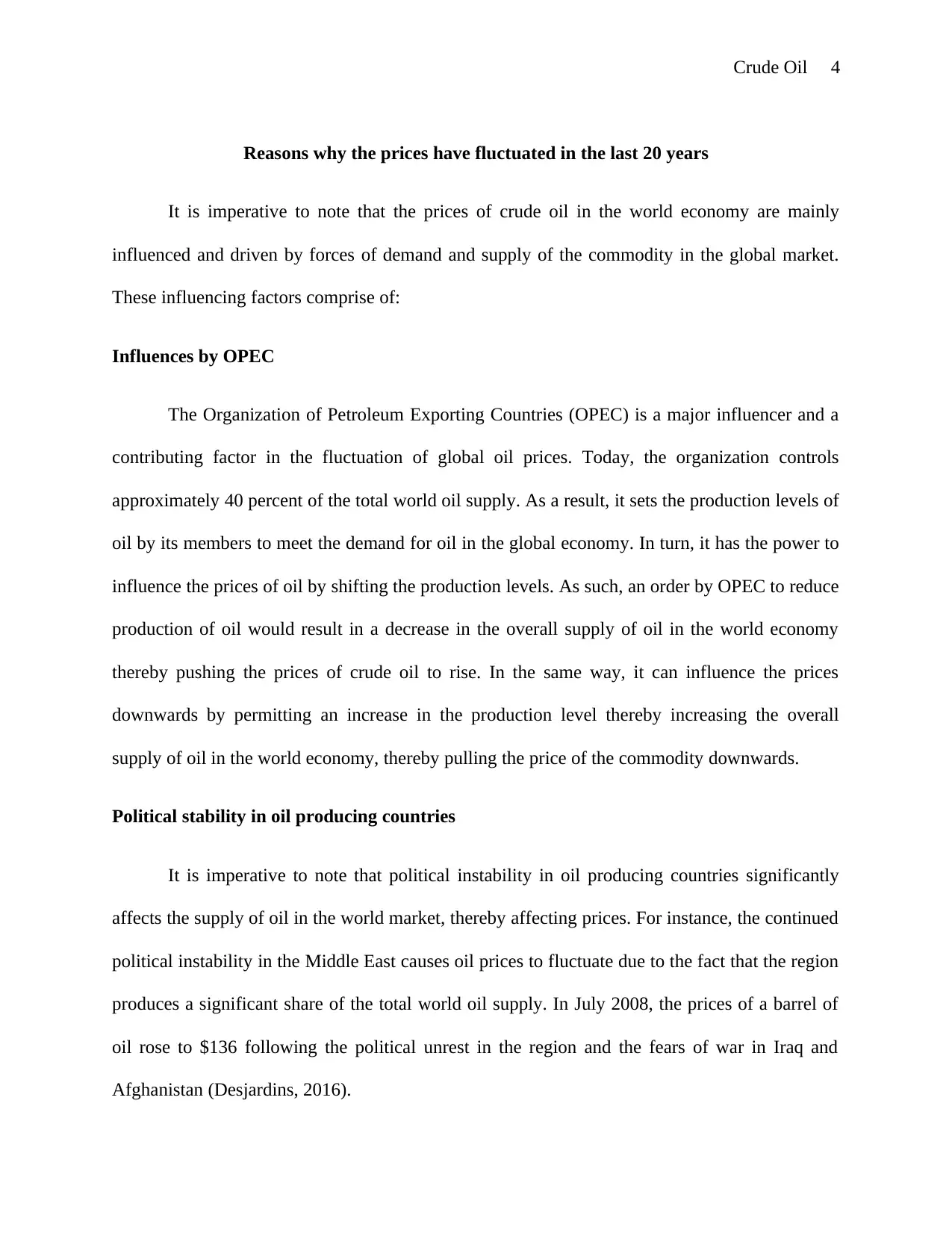
Crude Oil 4
Reasons why the prices have fluctuated in the last 20 years
It is imperative to note that the prices of crude oil in the world economy are mainly
influenced and driven by forces of demand and supply of the commodity in the global market.
These influencing factors comprise of:
Influences by OPEC
The Organization of Petroleum Exporting Countries (OPEC) is a major influencer and a
contributing factor in the fluctuation of global oil prices. Today, the organization controls
approximately 40 percent of the total world oil supply. As a result, it sets the production levels of
oil by its members to meet the demand for oil in the global economy. In turn, it has the power to
influence the prices of oil by shifting the production levels. As such, an order by OPEC to reduce
production of oil would result in a decrease in the overall supply of oil in the world economy
thereby pushing the prices of crude oil to rise. In the same way, it can influence the prices
downwards by permitting an increase in the production level thereby increasing the overall
supply of oil in the world economy, thereby pulling the price of the commodity downwards.
Political stability in oil producing countries
It is imperative to note that political instability in oil producing countries significantly
affects the supply of oil in the world market, thereby affecting prices. For instance, the continued
political instability in the Middle East causes oil prices to fluctuate due to the fact that the region
produces a significant share of the total world oil supply. In July 2008, the prices of a barrel of
oil rose to $136 following the political unrest in the region and the fears of war in Iraq and
Afghanistan (Desjardins, 2016).
Reasons why the prices have fluctuated in the last 20 years
It is imperative to note that the prices of crude oil in the world economy are mainly
influenced and driven by forces of demand and supply of the commodity in the global market.
These influencing factors comprise of:
Influences by OPEC
The Organization of Petroleum Exporting Countries (OPEC) is a major influencer and a
contributing factor in the fluctuation of global oil prices. Today, the organization controls
approximately 40 percent of the total world oil supply. As a result, it sets the production levels of
oil by its members to meet the demand for oil in the global economy. In turn, it has the power to
influence the prices of oil by shifting the production levels. As such, an order by OPEC to reduce
production of oil would result in a decrease in the overall supply of oil in the world economy
thereby pushing the prices of crude oil to rise. In the same way, it can influence the prices
downwards by permitting an increase in the production level thereby increasing the overall
supply of oil in the world economy, thereby pulling the price of the commodity downwards.
Political stability in oil producing countries
It is imperative to note that political instability in oil producing countries significantly
affects the supply of oil in the world market, thereby affecting prices. For instance, the continued
political instability in the Middle East causes oil prices to fluctuate due to the fact that the region
produces a significant share of the total world oil supply. In July 2008, the prices of a barrel of
oil rose to $136 following the political unrest in the region and the fears of war in Iraq and
Afghanistan (Desjardins, 2016).
Paraphrase This Document
Need a fresh take? Get an instant paraphrase of this document with our AI Paraphraser
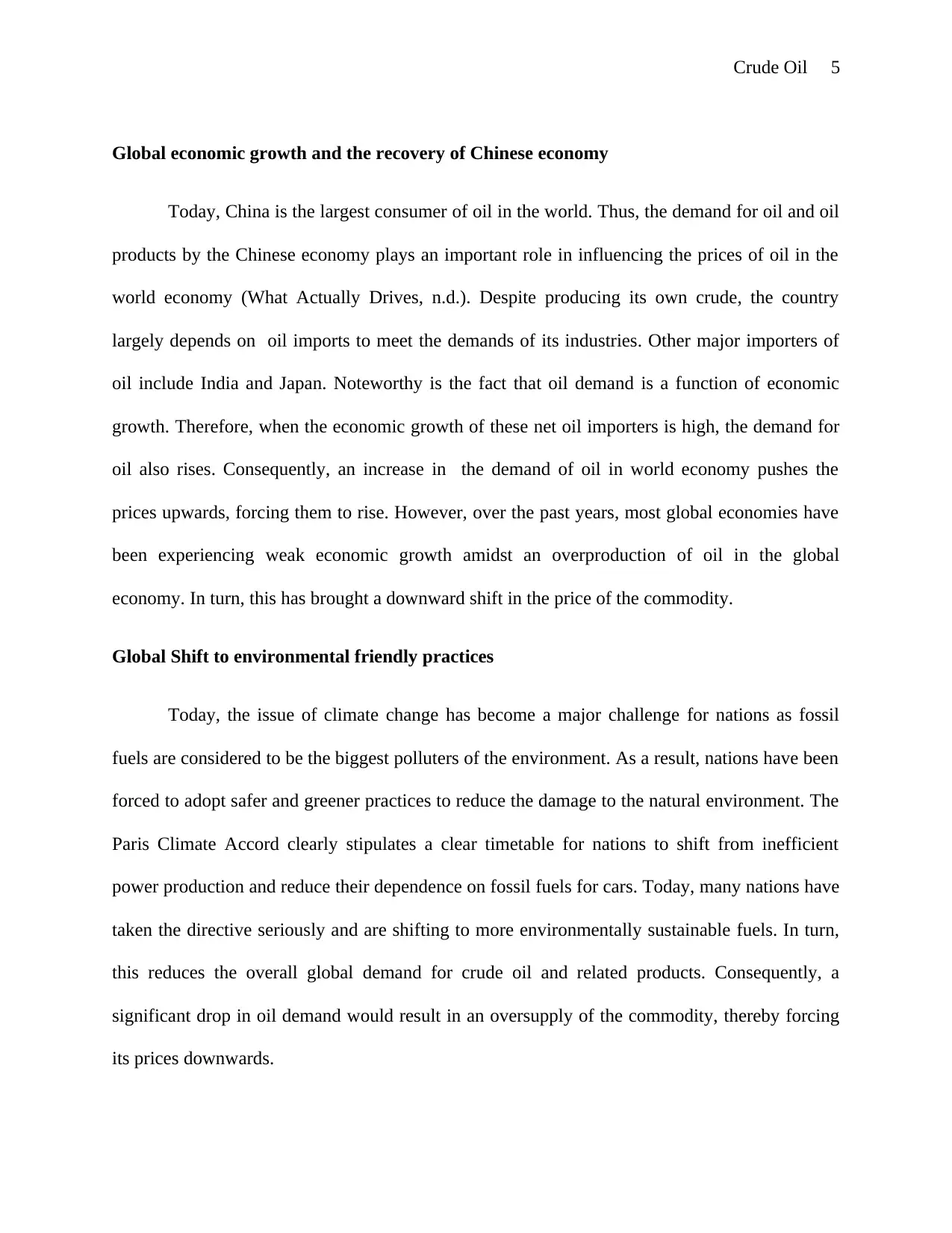
Crude Oil 5
Global economic growth and the recovery of Chinese economy
Today, China is the largest consumer of oil in the world. Thus, the demand for oil and oil
products by the Chinese economy plays an important role in influencing the prices of oil in the
world economy (What Actually Drives, n.d.). Despite producing its own crude, the country
largely depends on oil imports to meet the demands of its industries. Other major importers of
oil include India and Japan. Noteworthy is the fact that oil demand is a function of economic
growth. Therefore, when the economic growth of these net oil importers is high, the demand for
oil also rises. Consequently, an increase in the demand of oil in world economy pushes the
prices upwards, forcing them to rise. However, over the past years, most global economies have
been experiencing weak economic growth amidst an overproduction of oil in the global
economy. In turn, this has brought a downward shift in the price of the commodity.
Global Shift to environmental friendly practices
Today, the issue of climate change has become a major challenge for nations as fossil
fuels are considered to be the biggest polluters of the environment. As a result, nations have been
forced to adopt safer and greener practices to reduce the damage to the natural environment. The
Paris Climate Accord clearly stipulates a clear timetable for nations to shift from inefficient
power production and reduce their dependence on fossil fuels for cars. Today, many nations have
taken the directive seriously and are shifting to more environmentally sustainable fuels. In turn,
this reduces the overall global demand for crude oil and related products. Consequently, a
significant drop in oil demand would result in an oversupply of the commodity, thereby forcing
its prices downwards.
Global economic growth and the recovery of Chinese economy
Today, China is the largest consumer of oil in the world. Thus, the demand for oil and oil
products by the Chinese economy plays an important role in influencing the prices of oil in the
world economy (What Actually Drives, n.d.). Despite producing its own crude, the country
largely depends on oil imports to meet the demands of its industries. Other major importers of
oil include India and Japan. Noteworthy is the fact that oil demand is a function of economic
growth. Therefore, when the economic growth of these net oil importers is high, the demand for
oil also rises. Consequently, an increase in the demand of oil in world economy pushes the
prices upwards, forcing them to rise. However, over the past years, most global economies have
been experiencing weak economic growth amidst an overproduction of oil in the global
economy. In turn, this has brought a downward shift in the price of the commodity.
Global Shift to environmental friendly practices
Today, the issue of climate change has become a major challenge for nations as fossil
fuels are considered to be the biggest polluters of the environment. As a result, nations have been
forced to adopt safer and greener practices to reduce the damage to the natural environment. The
Paris Climate Accord clearly stipulates a clear timetable for nations to shift from inefficient
power production and reduce their dependence on fossil fuels for cars. Today, many nations have
taken the directive seriously and are shifting to more environmentally sustainable fuels. In turn,
this reduces the overall global demand for crude oil and related products. Consequently, a
significant drop in oil demand would result in an oversupply of the commodity, thereby forcing
its prices downwards.
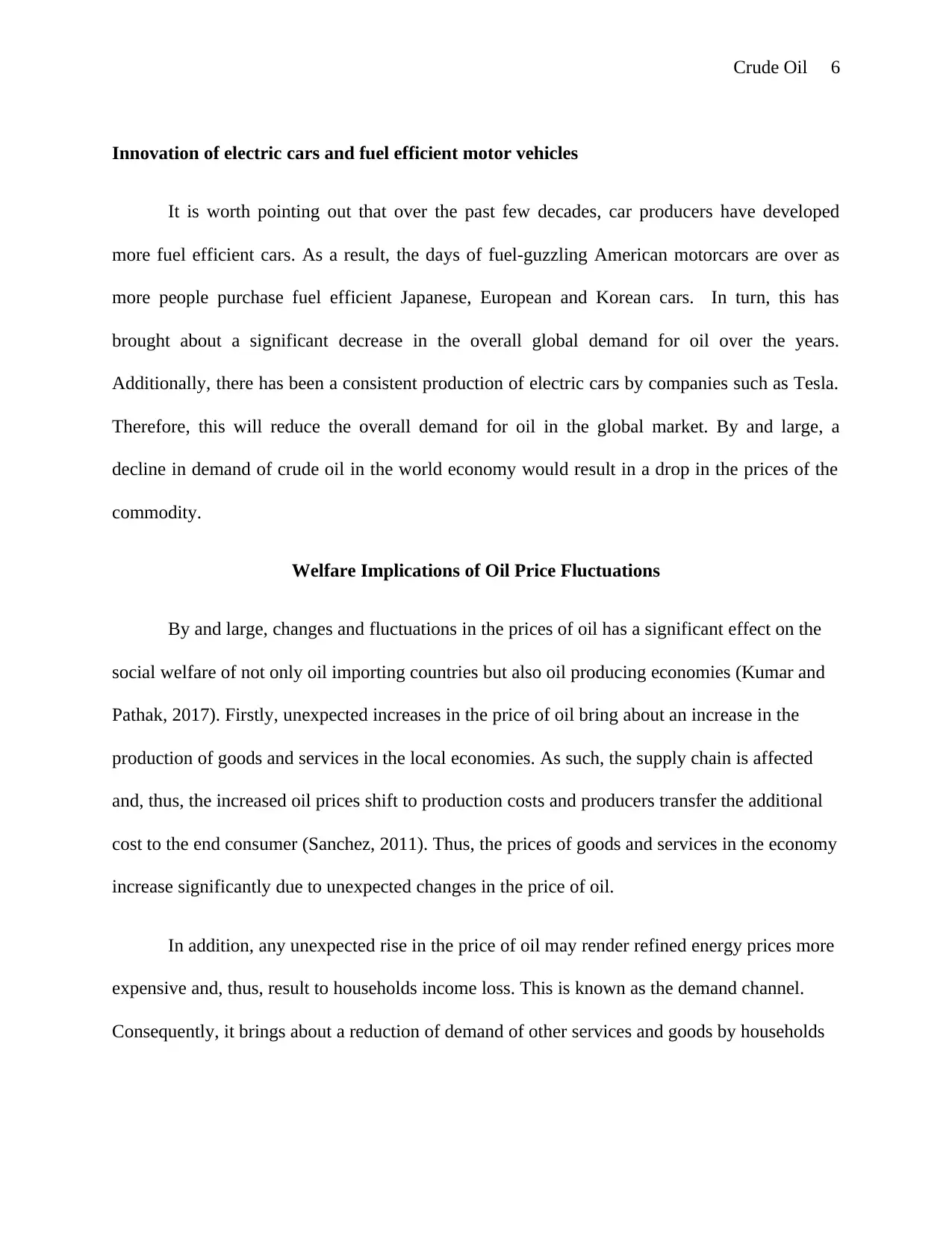
Crude Oil 6
Innovation of electric cars and fuel efficient motor vehicles
It is worth pointing out that over the past few decades, car producers have developed
more fuel efficient cars. As a result, the days of fuel-guzzling American motorcars are over as
more people purchase fuel efficient Japanese, European and Korean cars. In turn, this has
brought about a significant decrease in the overall global demand for oil over the years.
Additionally, there has been a consistent production of electric cars by companies such as Tesla.
Therefore, this will reduce the overall demand for oil in the global market. By and large, a
decline in demand of crude oil in the world economy would result in a drop in the prices of the
commodity.
Welfare Implications of Oil Price Fluctuations
By and large, changes and fluctuations in the prices of oil has a significant effect on the
social welfare of not only oil importing countries but also oil producing economies (Kumar and
Pathak, 2017). Firstly, unexpected increases in the price of oil bring about an increase in the
production of goods and services in the local economies. As such, the supply chain is affected
and, thus, the increased oil prices shift to production costs and producers transfer the additional
cost to the end consumer (Sanchez, 2011). Thus, the prices of goods and services in the economy
increase significantly due to unexpected changes in the price of oil.
In addition, any unexpected rise in the price of oil may render refined energy prices more
expensive and, thus, result to households income loss. This is known as the demand channel.
Consequently, it brings about a reduction of demand of other services and goods by households
Innovation of electric cars and fuel efficient motor vehicles
It is worth pointing out that over the past few decades, car producers have developed
more fuel efficient cars. As a result, the days of fuel-guzzling American motorcars are over as
more people purchase fuel efficient Japanese, European and Korean cars. In turn, this has
brought about a significant decrease in the overall global demand for oil over the years.
Additionally, there has been a consistent production of electric cars by companies such as Tesla.
Therefore, this will reduce the overall demand for oil in the global market. By and large, a
decline in demand of crude oil in the world economy would result in a drop in the prices of the
commodity.
Welfare Implications of Oil Price Fluctuations
By and large, changes and fluctuations in the prices of oil has a significant effect on the
social welfare of not only oil importing countries but also oil producing economies (Kumar and
Pathak, 2017). Firstly, unexpected increases in the price of oil bring about an increase in the
production of goods and services in the local economies. As such, the supply chain is affected
and, thus, the increased oil prices shift to production costs and producers transfer the additional
cost to the end consumer (Sanchez, 2011). Thus, the prices of goods and services in the economy
increase significantly due to unexpected changes in the price of oil.
In addition, any unexpected rise in the price of oil may render refined energy prices more
expensive and, thus, result to households income loss. This is known as the demand channel.
Consequently, it brings about a reduction of demand of other services and goods by households
⊘ This is a preview!⊘
Do you want full access?
Subscribe today to unlock all pages.

Trusted by 1+ million students worldwide
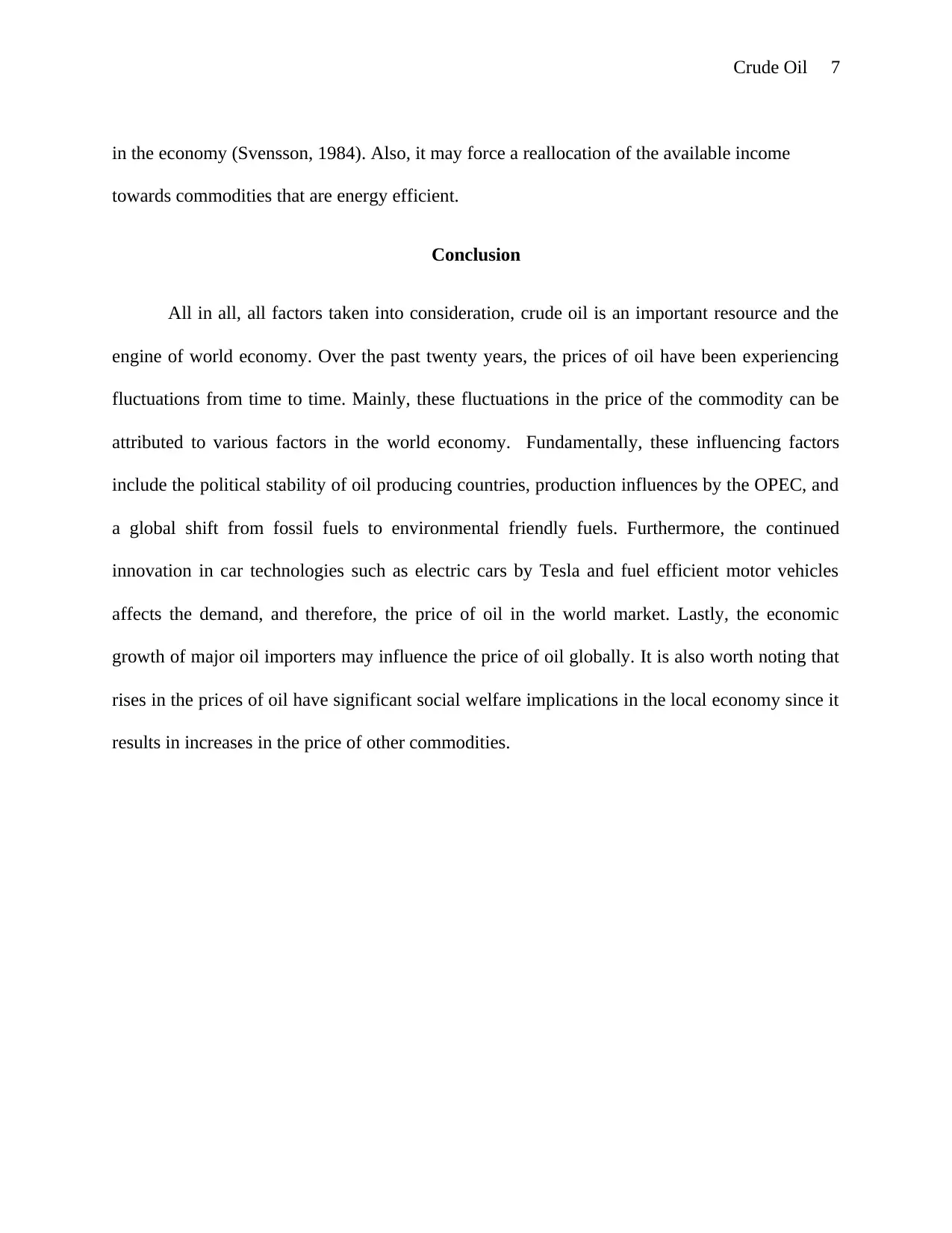
Crude Oil 7
in the economy (Svensson, 1984). Also, it may force a reallocation of the available income
towards commodities that are energy efficient.
Conclusion
All in all, all factors taken into consideration, crude oil is an important resource and the
engine of world economy. Over the past twenty years, the prices of oil have been experiencing
fluctuations from time to time. Mainly, these fluctuations in the price of the commodity can be
attributed to various factors in the world economy. Fundamentally, these influencing factors
include the political stability of oil producing countries, production influences by the OPEC, and
a global shift from fossil fuels to environmental friendly fuels. Furthermore, the continued
innovation in car technologies such as electric cars by Tesla and fuel efficient motor vehicles
affects the demand, and therefore, the price of oil in the world market. Lastly, the economic
growth of major oil importers may influence the price of oil globally. It is also worth noting that
rises in the prices of oil have significant social welfare implications in the local economy since it
results in increases in the price of other commodities.
in the economy (Svensson, 1984). Also, it may force a reallocation of the available income
towards commodities that are energy efficient.
Conclusion
All in all, all factors taken into consideration, crude oil is an important resource and the
engine of world economy. Over the past twenty years, the prices of oil have been experiencing
fluctuations from time to time. Mainly, these fluctuations in the price of the commodity can be
attributed to various factors in the world economy. Fundamentally, these influencing factors
include the political stability of oil producing countries, production influences by the OPEC, and
a global shift from fossil fuels to environmental friendly fuels. Furthermore, the continued
innovation in car technologies such as electric cars by Tesla and fuel efficient motor vehicles
affects the demand, and therefore, the price of oil in the world market. Lastly, the economic
growth of major oil importers may influence the price of oil globally. It is also worth noting that
rises in the prices of oil have significant social welfare implications in the local economy since it
results in increases in the price of other commodities.
Paraphrase This Document
Need a fresh take? Get an instant paraphrase of this document with our AI Paraphraser
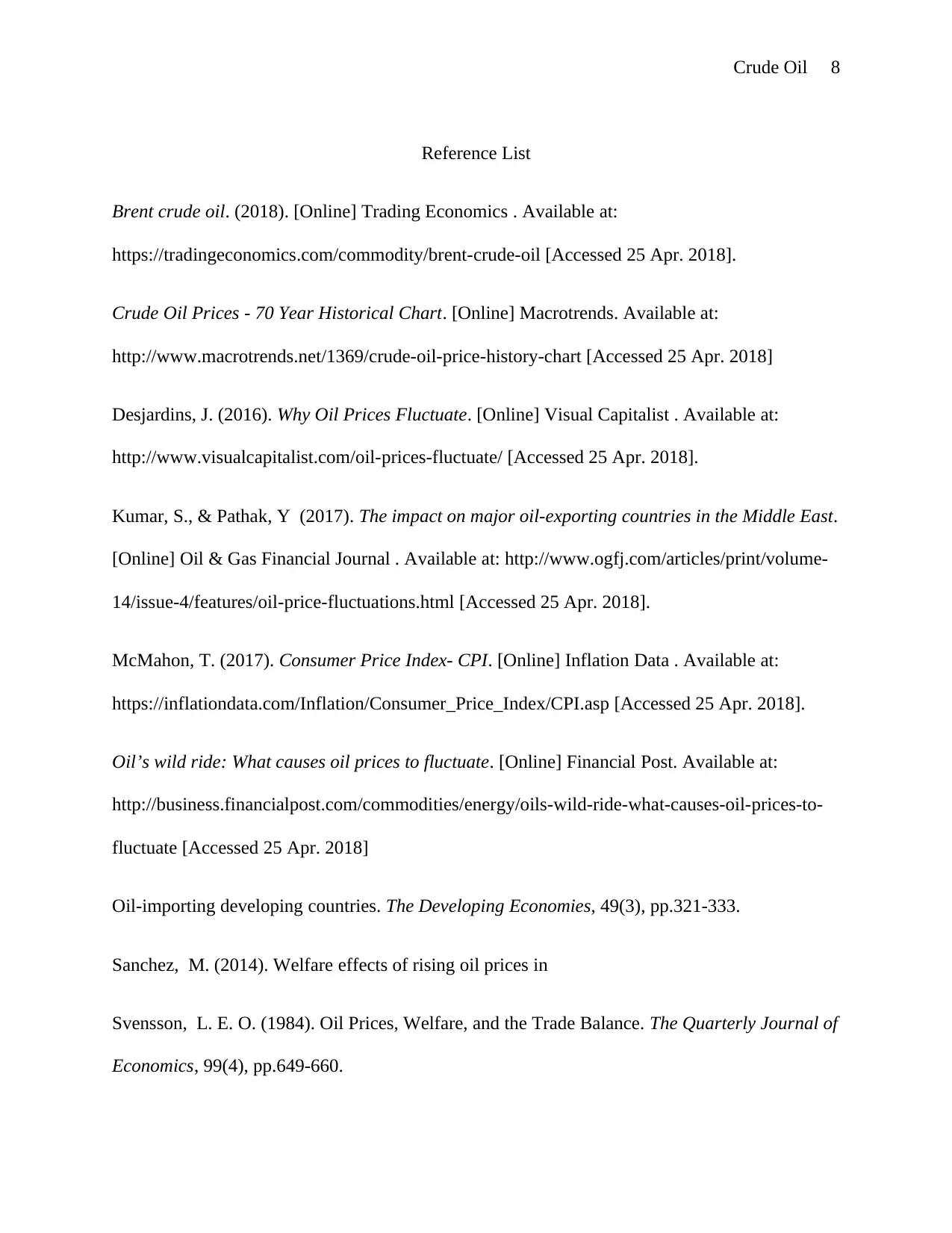
Crude Oil 8
Reference List
Brent crude oil. (2018). [Online] Trading Economics . Available at:
https://tradingeconomics.com/commodity/brent-crude-oil [Accessed 25 Apr. 2018].
Crude Oil Prices - 70 Year Historical Chart. [Online] Macrotrends. Available at:
http://www.macrotrends.net/1369/crude-oil-price-history-chart [Accessed 25 Apr. 2018]
Desjardins, J. (2016). Why Oil Prices Fluctuate. [Online] Visual Capitalist . Available at:
http://www.visualcapitalist.com/oil-prices-fluctuate/ [Accessed 25 Apr. 2018].
Kumar, S., & Pathak, Y (2017). The impact on major oil-exporting countries in the Middle East.
[Online] Oil & Gas Financial Journal . Available at: http://www.ogfj.com/articles/print/volume-
14/issue-4/features/oil-price-fluctuations.html [Accessed 25 Apr. 2018].
McMahon, T. (2017). Consumer Price Index- CPI. [Online] Inflation Data . Available at:
https://inflationdata.com/Inflation/Consumer_Price_Index/CPI.asp [Accessed 25 Apr. 2018].
Oil’s wild ride: What causes oil prices to fluctuate. [Online] Financial Post. Available at:
http://business.financialpost.com/commodities/energy/oils-wild-ride-what-causes-oil-prices-to-
fluctuate [Accessed 25 Apr. 2018]
Oil-importing developing countries. The Developing Economies, 49(3), pp.321-333.
Sanchez, M. (2014). Welfare effects of rising oil prices in
Svensson, L. E. O. (1984). Oil Prices, Welfare, and the Trade Balance. The Quarterly Journal of
Economics, 99(4), pp.649-660.
Reference List
Brent crude oil. (2018). [Online] Trading Economics . Available at:
https://tradingeconomics.com/commodity/brent-crude-oil [Accessed 25 Apr. 2018].
Crude Oil Prices - 70 Year Historical Chart. [Online] Macrotrends. Available at:
http://www.macrotrends.net/1369/crude-oil-price-history-chart [Accessed 25 Apr. 2018]
Desjardins, J. (2016). Why Oil Prices Fluctuate. [Online] Visual Capitalist . Available at:
http://www.visualcapitalist.com/oil-prices-fluctuate/ [Accessed 25 Apr. 2018].
Kumar, S., & Pathak, Y (2017). The impact on major oil-exporting countries in the Middle East.
[Online] Oil & Gas Financial Journal . Available at: http://www.ogfj.com/articles/print/volume-
14/issue-4/features/oil-price-fluctuations.html [Accessed 25 Apr. 2018].
McMahon, T. (2017). Consumer Price Index- CPI. [Online] Inflation Data . Available at:
https://inflationdata.com/Inflation/Consumer_Price_Index/CPI.asp [Accessed 25 Apr. 2018].
Oil’s wild ride: What causes oil prices to fluctuate. [Online] Financial Post. Available at:
http://business.financialpost.com/commodities/energy/oils-wild-ride-what-causes-oil-prices-to-
fluctuate [Accessed 25 Apr. 2018]
Oil-importing developing countries. The Developing Economies, 49(3), pp.321-333.
Sanchez, M. (2014). Welfare effects of rising oil prices in
Svensson, L. E. O. (1984). Oil Prices, Welfare, and the Trade Balance. The Quarterly Journal of
Economics, 99(4), pp.649-660.
1 out of 8
Related Documents
Your All-in-One AI-Powered Toolkit for Academic Success.
+13062052269
info@desklib.com
Available 24*7 on WhatsApp / Email
![[object Object]](/_next/static/media/star-bottom.7253800d.svg)
Unlock your academic potential
Copyright © 2020–2025 A2Z Services. All Rights Reserved. Developed and managed by ZUCOL.





